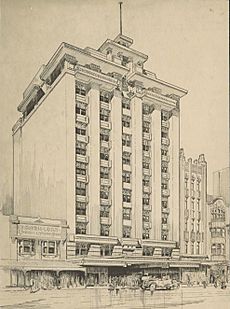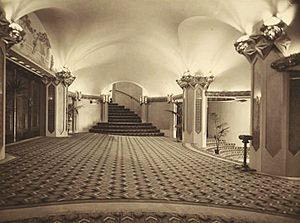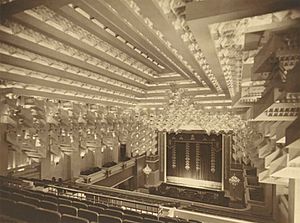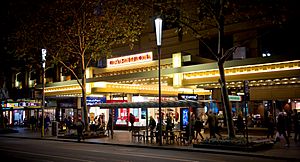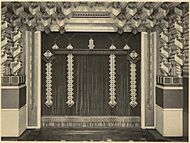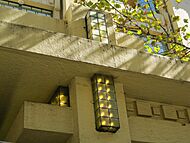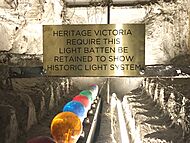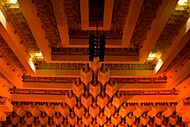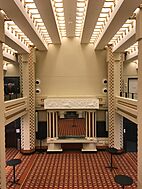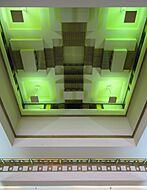The Capitol, Melbourne facts for kids
| RMIT Building 113 | |
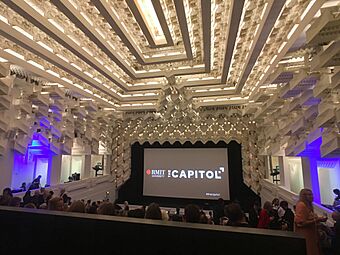
Auditorium ceiling
|
|
| Address | 113 Swanston Street Melbourne, Victoria, Australia |
|---|---|
| Coordinates | 37°48′55″S 144°57′59″E / 37.81536°S 144.96636°E |
| Owner | RMIT University |
| Designation | Victorian Heritage Register |
| Capacity | 554 and 8 accessible spaces |
| Current use | Education, events |
| Construction | |
| Opened | 1924 |
| Architect | Walter Burley Griffin Marion Mahony Griffin |
The Capitol is a famous theatre located on Swanston Street in the heart of Melbourne, Australia. It first opened its doors in 1924. This amazing building was designed by a talented husband and wife team, Walter Burley Griffin and Marion Mahony Griffin.
The Capitol is Melbourne's oldest large "picture palace." These were grand cinemas built to make watching movies a special experience. The theatre is famous for its fancy decorations and unique designs. Its most amazing feature is a detailed ceiling with thousands of coloured lights. These lights were made to look like the inside of a sparkling crystal cave.
In the 1960s, there were plans to knock down the theatre. However, people who loved old buildings, like architect Robin Boyd, fought to save it. They succeeded, and the theatre was kept, though some parts were changed.
RMIT University bought The Capitol in 1999. They use it for classes and events. From 2014 to 2019, the theatre had a big restoration. It reopened in 2019 and now hosts film festivals, plays, concerts, and other fun events. The Capitol is protected as an important heritage site in Australia. Its unique design is considered a "technical triumph."
Contents
History of The Capitol Theatre
Building a Masterpiece
The idea for The Capitol Theatre came from a group of Melbourne business people. This group included Antony J. Lucas, who was the Greek Consul-General, and the Phillips brothers. The Phillips brothers had also helped create Luna Park and the Palais Theatre in St Kilda.
The main architects for The Capitol were Walter Burley Griffin and Marion Mahony Griffin. Marion Mahony Griffin was especially known for her amazing interior designs. Antony J. Lucas had worked with the Griffins before on other projects.
Official plans for The Capitol were approved in 1923. The theatre was finished and officially opened on November 7, 1924. It was part of a larger building called Capitol House. This building had shops, a cafe, and a 10-story office tower.
The theatre itself was immediately seen as a special work of art. People were amazed by its design. One magazine in 1924 said, "It is no use trying to describe it. A hundred visits would be necessary to study every feature of this wonder building."
The Capitol is known for its clever design that allowed different parts of the building to work together. The most famous part is the theatre's ceiling. It has sharp, crystal-like shapes made from plaster. This design was inspired by nature, looking like a glittering cave.
The ceiling also had about 4,000 hidden coloured lights. These lights could change colours (red, yellow, blue, green). They were controlled to create different effects during silent films. This added drama and excitement for the audience.
The Capitol was also home to Australia's first large Wurlitzer Organ. This organ played music and sound effects for films. It was also used for musical shows between movies. The organ was often heard on the radio.
When it first opened, the theatre could seat 2,137 people. Later, in the 1930s, some changes were made, and the seating capacity became 2,115.
Saving the Theatre from Demolition
In the late 1950s, television became popular. Fewer people went to the cinema, and many theatres struggled. In the early 1960s, the company running The Capitol decided not to renew their lease. At that time, many old buildings were being torn down to make cities look more modern.
The Capitol theatre was set to close. But a strong campaign began to save it. The National Trust of Australia and famous architects like Robin Boyd led the effort. Robin Boyd called The Capitol "the best cinema that was ever built."
A solution was found to save the theatre. It closed for renovations in November 1963. The street-level entrance and some seating areas were removed to create a shopping arcade. However, the famous ceiling and the upper part of the auditorium were kept.
The theatre reopened in December 1965. It became a single-level cinema with 600 seats. The Wurlitzer organ was moved to another cinema. The first film shown after the renovation was The Great Race. Other popular movies also played there for a long time. In the 1990s, the cinema was used for film festivals and special movie screenings.
The Capitol's Recent Story
In 1999, RMIT University bought The Capitol. They wanted to protect the historic building and use it as a large lecture hall for students. They worked with architects to restore the building. This included reconnecting different lobby areas and making the building safer. They also added access for people with disabilities.
The restoration included new audio and visual systems. The coloured lighting in the ceiling was also brought back to life. In 2005, RMIT received money to help repair the unique crystalline ceiling even more.
The theatre closed to the public in 2014 because it needed a very big restoration. In 2017, RMIT asked for help to bring the landmark back to life. The owners of the shopping arcade also decided to update their space.
This was the first full restoration of the theatre. It included new services, better access, new seats, and modern projection equipment. All the decorative plasterwork was cleaned and repaired. The carpets were remade to look like the originals. The old coloured globe lights in the auditorium were replaced with new LED lights. These new lights can create endless colours and patterns.
The restored theatre officially reopened on June 3, 2019, to much excitement.
In 2021, the original Wurlitzer organ, nicknamed "Eliza," returned to The Capitol. It had been at another cinema for 54 years. RMIT University and the Theatre Organ Society of Australia are working to raise money to reinstall the organ.
The Capitol is officially listed as an important heritage site by several Australian organizations.
Gallery


